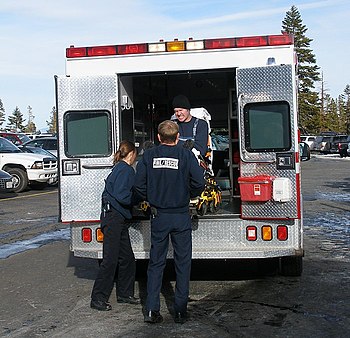 |
| English: In this photograph, emergency medical technicians of the North Lake Tahoe Fire District are loading a patient into an ambulance for transport to a hospital. The patient is being evacuated from the First Aid building at the Mount Rose Ski Area on Nevada State Route 431 between the cities of Incline Village and Reno. (Photo credit: Wikipedia) |
Emergency Medical Technicians (EMTs) provide emergency medical care to persons who are sick or injured. In addition to giving urgent medical attention, EMTs usually transport patients to medical facilities. EMTs are generally the first medical personnel on the scene when a call for help is placed. There are three categories of emergency medical technicians: EMT-Basic, EMT-Intermediate, and EMT-Paramedic.
EMTs generally work in teams of two and respond to calls from a central dispatcher. Upon arrival, EMTs must assess the nature of the injury or illness and call for additional help if necessary. Following strict guidelines, all EMTs are authorized to initiate procedures such as opening airways, controlling bleeding, administering oxygen, and aiding with childbirth. Intermediate and Paramedic EMTs are allowed to give intravenous fluid, administer drugs both orally and intravenously, as well as provide several other advanced medical procedures.
After initial treatment is applied, victims are usually placed on a stretcher, secured in the ambulance and then transported to the nearest medical facility. Occasionally, patients are transported by helicopter to regional centers. Upon arrival at the medical facility, patients are brought to the emergency care department where the EMTs report on the patient’s status and initial care. Hospital personnel usually take over at this point.
Education and Training
In the U.S., Emergency Medical Technicians need one of the following three levels of education and training: EMT-Basic, EMT-Intermediate, and EMT Paramedic.
EMT-Basic
Training program includes 110 to 120 hours of classroom work and 10 hours of internship at a hospital emergency room. Candidates must pass a written and practical examination.
Training program includes 110 to 120 hours of classroom work and 10 hours of internship at a hospital emergency room. Candidates must pass a written and practical examination.
EMT-Intermediate
Training program typically includes an additional 35-55 hours of instruction.
Training program typically includes an additional 35-55 hours of instruction.
EMT-Paramedic
Training program includes between 750 and 2,000 hours of classroom instruction.
Training program includes between 750 and 2,000 hours of classroom instruction.
As would be expected, each subsequent level of training prepares students to administer more advance medical care. EMTs must register for certification every two years.
On the Job
Since they are usually the first on the scene, EMTs need to be able to quickly assess a situation and then determine an appropriate course of action. EMTs must be capable of working in an environment that is emotionally and physically demanding.
Math on the Job
Emergency Medical Technicians need to be able to assess a particular situation and quickly determine the type of care required. Strong logic and reasoning skills greatly enhance an EMT’s ability to correctly identify the appropriate treatment. The administration of appropriate medical dosages requires solid arithmetic skill. EMTs are also very organized and detail-oriented.
No comments:
Post a Comment